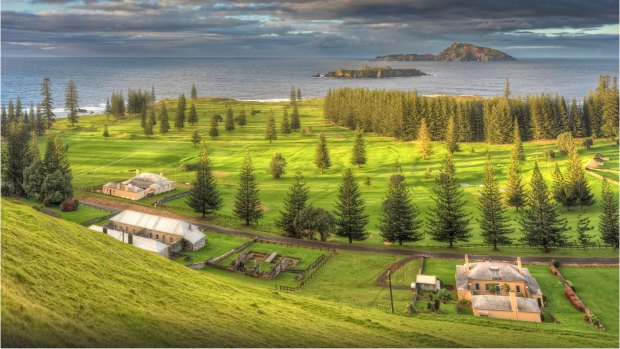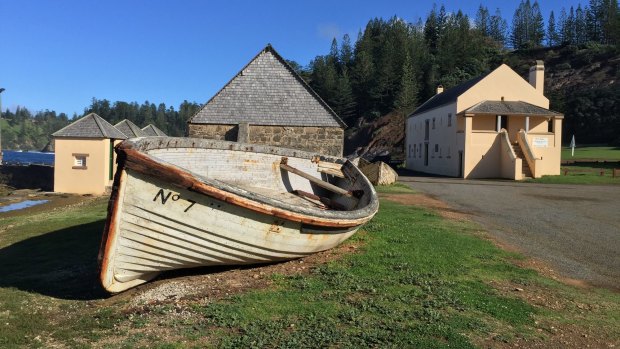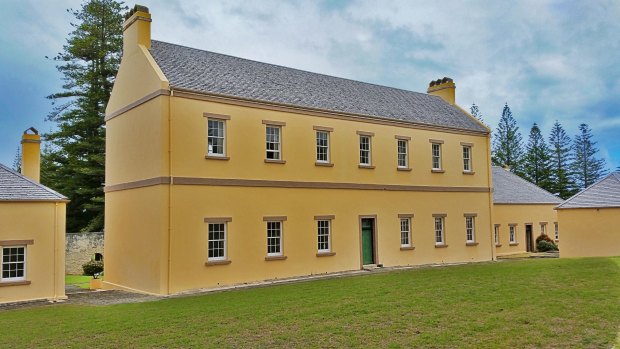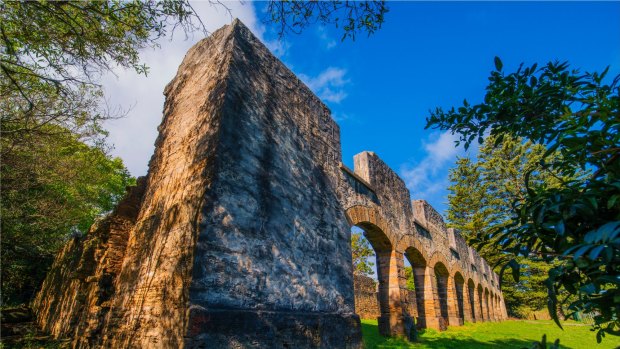This was published 7 years ago
Norfolk Island: Curious castaways in anyone's language
By Max Anderson

Beautiful and dramatic dawn light sweeps over the Kingston Gold course on Norfolk island.Credit: Getty Images
The Burnt Pine Bowling Club is no different to any lawn green bowls club in Australia. Beige decor. Faded team photos. Blokes with accents as broad as a Kingswood front seat.
"Gee," growls one over his VB, "the Rabbitohs are shithouse this year."
Another drains his beer: "We go rumma morla?"

Norfolk Island.Credit: Max Anderson
Yet another shakes his head: "I se sly, suff too big."
I've been hoping for this, but still I blink in astonishment. Not because the bowler has asked if they're fishing tomorrow, nor because he's told the seas are too rough. But because these boofy, Anglo-looking Australians are speaking Norf'k, a language that mixes 18th century sailor's English with Tahitian.
Norfolk Island is home to 1700 people and half speak Norf'k. It sounds yokel-ish, a little West Country English, only it's usually spoken between islanders when they think no one's listening – a hangover perhaps from when Australian government schoolteachers tried to belt it out of islander kids.
Never have I been so flummoxed by my home country. So intrigued. So where-the-bloody-hell-am-I?
This means the 30,000 visitors to Norfolk, most of them Australian retirees, rarely get to hear it outside of being greeted with "Watawieh".
Not that they necessarily mind, so busy are they enjoying Norfolk's distinctive charms.
They stand on 319-metre Mount Pitt, a volcanic remnant looking down on the 40-square-kilometre island to enjoy views over magnificent pines and Pacific waters. They beetle around in tiny Toyota Tictacs and Hyundai Dotz, discovering farmhouse food producers, sheltered bays and golden beaches. And when the sun sets on stunning Anson Bay, they're in for a little time-warp tourism on the clifftop, with crooners singing Elvis and young girls dancing the hula.

Norfolk Island historical military barracks, 1830's British architecture, now used as the chambers of the Legislative Assembly. Credit: Alamy
Visitors from the Travelers' Century Club (people who have been to more than 100 countries) have declared Norfolk Island the most interesting place they've ever been. And on this – faux Polynesian hula or no – I agree.
Because never have I been so flummoxed by my home country. So intrigued. So where-the-bloody-hell-am-I?
Local guide Rick Kleiner was born in California to a Norf'k-speaking mother. He worked for NASA as a mission planner, helping the first Rover to travel 54 million kilometres to Mars. And in 1997, he moved here.

Norfolk Island.Credit: Getty Images
"People of Norfolk descent raised off-island have a sense of where they're from," he says. "And they're told they'll always have a place to go."
At Kingston Pier we watch the winter waves. They come in fat peals, whoofing against the implacable stone jetty built by convicts in 1839.
"Most of the world today is containerised except this last 200m to Norfolk Island," Rick says. "The cargo ships can't get past the reef, so stevedores bring the cargo in on small timber boats. It still requires consummate maritime skill. When a new bus came onto the island they strapped three boats together and laid it crossways..." The first Qantas planes landed only after the war, when General Douglas MacArthur ordered an airstrip be ploughed through the island. Norfolk is still two weeks sailing or two hours flying from the mainland, and to this day the people are incredibly self-reliant.
Many also respectfully but quite clearly say they are not Australian – they are "Islander".
Curious traditions persist. They celebrate Thanksgiving (a throwback to 19th-century American whalers who wintered here). They eat overly ripe bananas in a baked dish called pilihi (it's delicious). And on June 8, the whole island gathers on Kingston Pier to celebrate Bounty Day.
Bounty Day commemorates when eight families landed in 1856. They came from Pitcairn Island and half of today's population are descendants. The other half are mostly mainland Australians, but "the national day" sees everyone dressed in period costume with hats plaited (not woven) from flax and banana leaves. After marching, there's a grudge cricket match when the "Bounty Boys" play the "All Comers".
The thickly walled Pier Store houses a Norfolk folk museum. Here I learn the islanders' extraordinary story.
It begins with the famous 1790 mutiny on HMAV Bounty, when William Bligh is cast into a small boat, nine mutineers sail their Tahitian women to a two-square-kilometre rock called Pitcairn Island, and the Bounty is torched to hide their crime.
The next 10 years sees murder and madness on Pitcairn and the begetting of children with five surnames – Christian, Adams, Quintal, McCoy and Young. Not unrelated, hallucinogenic moonshine is brewed in a copper kettle rescued from the Bounty. One night in 1800, the last surviving mutineer John Adams sees the Archangel Michael who instructs him that Pitcairn's children must be taught to read from the ship's Bible. He also tells him to swear off the grog.
In 1808, an American whaler discovers a community of 35, all literate and speaking their strange hybrid tongue. Britain soon learns of the heathens who have returned to the bosom of the Lord and Pitcairn becomes a cause celebre. Christian societies begin sending regular mercy packages. Meanwhile three more Englanders join, Evans, Nobbs and Buffet (the "All Comers"). By 1856, the tribe numbers 193. And tiny Pitcairn is exhausted.
So Queen Victoria herself grants the eight families a new home and commands the Morayshire to sail them 6000 kilometres to Norfolk.
"It's the ultimate story of redemption," says Rick. "Even today the people of Norfolk still venerate Queen Victoria."
We're leaning on a glass cabinet, looking down on a battered, heavily riveted bucket. It's the moonshine kettle from which the original Bounty Boys drank.
The Pitcairners arrived on the stone pier to be greeted by a virtually empty island – and the grim sight of Kingston penal settlement, abandoned by the British one year before.
Today, this sprawling complex comprises both ruins and some of the best-preserved original Georgian architecture in the world. It's quite bucolic, with pier and beaches on one side and cows cropping meadow on the other. When the dawn light rises on Bloody Bridge, Murderer's Mound and Slaughter Bay, it's more magical than morose.
Yet this is a very Australian piece of history.
Kingston was built to break the "iron" convicts who resisted even the worst persuasions of Port Arthur. For 30 years, mostly sadistic commandants pushed human endurance to new limits. One convict was flogged so often his collar bones were permanently exposed like "ivory polished horns". Worse than flogging was the dreaded Crank Mill – a human-powered contraption that ground spirits as well as wheat, sounding to "cries, wails, grunts and dirges … like the orgy of the damned". Bits of it survive in the earthy-smelling Kingston Commissariat Store, one of four museums onsite.
Rick admits to being "sad" for the agonies of the men, while other islanders take inspiration from the convicts' dogged insolence (one had his back tattooed with the words: "Do your duty well"). Occasionally I sense that the Islanders are custodians of Kingston – like they're looking after someone else's war dead.
One part of Kingston's heritage, however, is quite alive. The grounds of the 1820s Soldiers Barracks has been occupied by a "Tent Embassy". "ADMINIS-TRAITOR!" reads one banner. ''Come in for coffee and cake!" reads another.
Within the high-walled compound, I find six Islanders smoking roll-ups beneath tarps pooling with rainwater. A swarthy bloke called Ernie has been camped here for four months: "We want our self-government back," he says. "We want to govern ourselves, in free association with Australia."
The island was British until 1914. Then it was Australian. And in 1979, recognising that Norfolk was pretty much running its own show, Canberra gave the islanders limited self-government. Despite having a population akin to Leura or Daylesford, Norfolk had its own treasury, taxation, pension and health scheme. It even set up its own airline.
But it also ran up a debt of $14 million, and in July this year, Canberra shut the parliament, ordering that governance be transferred to Federal Government. The issue is hot, with 70 per cent of the island angry.
"How long are you planning to protest?" I ask.
"As long as it takes," says Ernie. "I ain't leaving."
On my last day I'm supposed to be fishing, but Sunday's dawn sounds only of heavy rain. So I tell Rick Kleiner what I'd like to do instead – at which he laughs.
"Church?! Oh boy! And it's High Church at that!"
St Barnabas' Chapel has all the gravity of its 136 years, with a venerable gloom cast by timber, stone and a stunning "rose" window designed by William Morris. Fifty islanders sit listening to organ music, among them the parents of baby Josie, a new Norfolk Islander who is to be baptised.
Rick whispers to me: "Y'know, there was an Australian who said to me, 'Where's all this Norfolk culture I keep hearing about?' I said to him, 'The first Pitcairn Islanders spoke both king's English and Tahitian. They were bilingual and bicultural from the very beginning.
"But I guess the Anglo culture only sees the Anglo aspect."
A congregation member leads us in the prayer of John Adams. Like most Norfolk people today, he looks and sounds like an Anglo Australian. He gives a mumbled preamble: "Um, as you know John Adams was the last surviving member of the Bounty crew. He turned them around to follow the Lord and teach the children to read and write."
The prayer begins, many reciting effortlessly after a lifetime of repetition: Suffer me not O Lord to waste this day in sin or folly. But Let me worship thee with much delight…
I listen, feeling powerfully moved. Language is story. Story is culture. Culture is identity. And Norfolk Island is Australia-but-not-Australia, a bastard bunyip, a place of monumental beauty and unthinkable brutality settled by a tribe of castaways whose short history you couldn't make up.
If you think you understand Australia, it's probably time to visit Norfolk Island.
TRIP NOTES
MORE INFORMATION
GETTING THERE
Air New Zealand (airnewzealand.com.au) flies direct to Norfolk Island from Sydney and Brisbane. It's a curious international/domestic flight and you'll need passport or driver's licence.
STAYING THERE
Very pleasant cabins at Governor's Lodge Resort (see governorslodgeresort.com/) from $160 a night.
Governor's Lodge Resort Hotel – seven-night package from $1299 a person. This includes return airfares with Air New Zealand and transfers; seven nights' accommodation at Governor's Lodge in a standard one bedroom executive lodge; eight days' car hire; VIP on island concierge; continental breakfasts; welcome dinner including Tahitian fish-making demonstration; Wonderland by Night show; half-day orientation tour; Life as a Convict and Pitcairn Pioneers tours; Norfolk Language Class; World of Norfolk Exhibit, iPod Tour.
Max Anderson was a guest of Norfolk Island Tourism
DON'T MISS…
Kingston Museum Tour: Racheal McConnell does a sensational two-museum tour in Kingston. In the Pier Store Folk Museum she unveils the chaos, colour and misconceptions of the Bounty story. And in the Sirius Museum she inspires audiences with "the Australian equivalent to the Mayflower" which lies wrecked a few metres off Kingston Pier.
Lantern Lit Ghost Tour: "Rachel" is both kooky and spooky as she wends like a lamplit sprite through Kingston cemetery, illuminating the lives of people from rebel convicts to author Colleen McCullough. See bauntiescapes.com.
Two Chimneys Wines: Rod McAlpine and Noelene Buffet have a lovely cellar door (actually, the cellar door), offering premium wines. You're unlikely to be served a more colourful platter anywhere, a veritable bouquet harvested from Noelene's garden. See twochimneywines.nlk.nf.
Hilli Restaurant: Great restaurant in a lovely island-style cottage; after 10pm (and a few beers) you may get to hear some Norf'k. hillirestaurant.com/
The Jolly Roger: Overcome your fear of pirates (and music-show restaurants) because singer/owner Mattie Zarb is an outstanding talent, the food is terrific and the essential spirit of the island is always being paid forward. See thejollyrogerbar.com/
The Cyclorama: This humble and beautiful retelling of the Pitcairn/Norfolk story uses curved mural and contemporary audio technology. A homage to a Victorian-era fashion, it's surprisingly evocative. See norfolkcyclorama.nlk.nf.
The phone book: Turn to the page titled Faasfain "Salan Bai Dems Nikniem" ("Fast find Someone by their Nickname"). Under Christian I found Barley, Geek, Toofy, Moochie, Sparks, Moony, Loppy and – yes – Fletch.
A personal tour of the island with Rick Kleiner: This thoughtful, knowledgeable host is a descendant of mutineer Young and knows how to get you to most places. Including the surface of Mars. See personaltours-ni.com.
Sign up for the Traveller Deals newsletter
Get exclusive travel deals delivered straight to your inbox. Sign up now.